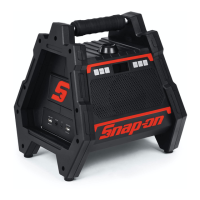What to do if Snap-On Radio shows undervoltage?
- TtammystewartAug 3, 2025
If the Snap-On Radio battery charger indicates an undervoltage issue or a CTL failure, replace the discharged battery with a fully charged one.

What to do if Snap-On Radio shows undervoltage?
If the Snap-On Radio battery charger indicates an undervoltage issue or a CTL failure, replace the discharged battery with a fully charged one.
What to do if Snap-On Radio has hardware fault?
If you suspect a motor wire break, controller fault, hardware fault, or Hall effect error with your Snap-On Radio, it needs professional attention. Return it to the dealer for repair.
Read all safety warnings and instructions for preventing electric shock, fire, or serious injury.
Maintain a clean, well-lit area and avoid explosive atmospheres for accident prevention.
Take precautions to prevent electric shock from tools, plugs, and wet conditions.
Stay alert, use common sense, and wear appropriate personal protective equipment.
Proper operation, maintenance, and storage of power tools to ensure safety.
Safe charging, handling, and maintenance of battery packs to prevent injury or fire.
Covers safe handling, noise, vibration, and motion awareness during tool use.
Protects against dust, entanglement, and flying particles during operation.
Addresses tool damage and safe cleaning practices, avoiding flammable liquids.
Avoid high temperatures, incineration, and short-circuiting battery terminals.
Do not disassemble or short circuit; prevent terminal contact with metal objects.
Avoid battery liquid contact; flush with water if contact occurs.
Recycle used batteries through authorized centers to protect the environment.
Protect exposed terminals with tape before recycling to prevent fire.
Do not insert cracked battery pack; use correct power cord and outlet.
Follow all instructions and cautionary markings on charger, battery, and product.
Charge only specified battery types; protect charger from moisture and damage.
Unplug before maintenance; use qualified service for repair and replacement.
Supervise children; do not recharge non-rechargeable batteries.
Details on battery type (Lithium-Ion) and voltage (18 VDC).
Information on battery weight and charging duration for different models.
Insert power cord, plug into outlet, and insert battery pack into charger.
Understanding LED lights for charging status, battery percentage, and faults.
Full charge indicated by solid green lights on battery and charger.
Handling hot or cold batteries; charger won't fast charge outside 32-113°F range.
Red flashing LED indicates a faulty battery; charger will not charge.
Charger has a USB port with 0.5A output for charging devices.
Using the fuel gauge to check capacity and the button to read charge cycles.
Monitors voltage, amperage, and temperature to protect the battery.
Use tool at no load to warm battery in cold temperatures.
Battery protection circuit turns off if temperature reaches 158°F (70°C).
Store fully charged batteries at room temperature, away from moisture.
Service by qualified technician; check for damaged parts before use.
Useful life is 1000 cycles; improper care shortens battery life.
Unplug charger and remove battery pack before disassembly.
Explanation of symbols for hazards, protection, and compliance.
Diagnosing and resolving issues like undervoltage, overtemperature, and faults.
Identification and function of buttons, display, and ports on the speaker unit.
Technical specifications including power supply, output, and consumption.
Device complies with Part 15 of FCC Rules; subject to two conditions.
Designed for dry conditions; avoid wet conditions or flammable gases/liquids.
Instructions for inserting and removing the 18V battery pack.
Connect the power cord to the speaker and a grounded outlet.
Steps to pair the speaker with a Bluetooth device.
Connect to external speakers or headphones via the headphone jack.
Connect non-Bluetooth devices using an AUX cable.
Volume control via connected device or speaker's volume knob.
Instructions for playing, pausing, advancing, and returning to tracks.
Chaining two speakers for stereo sound via Bluetooth pairing.
Two onboard USB ports for charging external devices.
Audio pauses during incoming calls and resumes automatically when call ends.
Diagram and list of all components for the speaker unit.
Solutions for no power, including plug connection and battery status.
Resolving issues with volume levels and sound output.
Troubleshooting connection problems and ensuring playback mode.
Details of the warranty, including coverage, limitations, and exclusions.
Instructions for requesting warranty service and required proof of purchase.
Provides contact details for technical support and service.
Warning against unauthorized modifications; guidelines to correct interference.
Equipment complies with RF exposure limits for uncontrolled environments.
